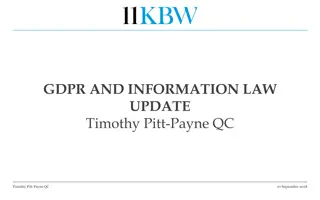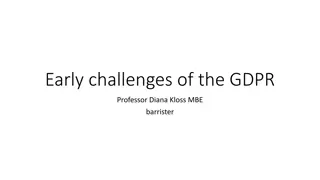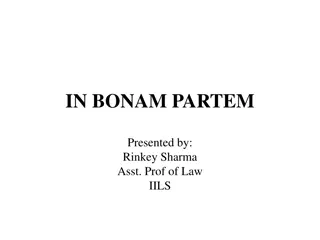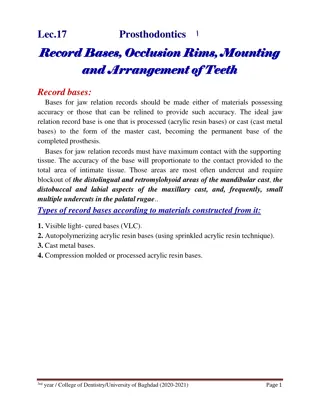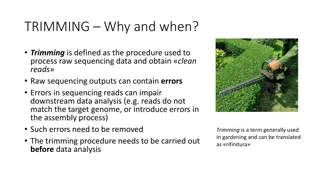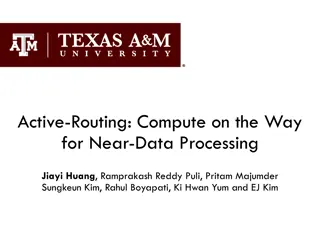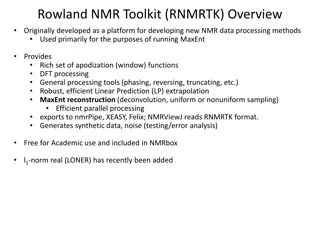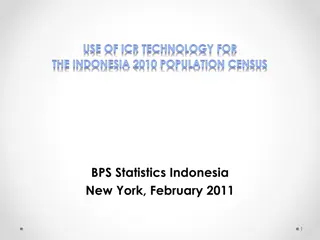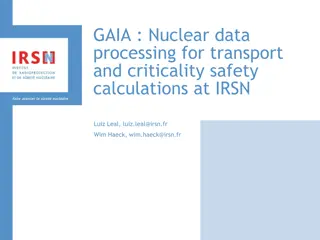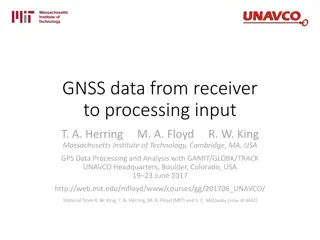Understanding Lawful Bases in AI Data Processing
Explore the importance of identifying lawful bases when utilizing AI, considerations for statistical accuracy, addressing bias and discrimination risks, and ensuring transparency in AI processes. Discover guidance from the ICO and The Alan Turing Institute on explaining decisions made with AI, and learn about applicable lawful bases for processing personal data in AI systems.
Download Presentation

Please find below an Image/Link to download the presentation.
The content on the website is provided AS IS for your information and personal use only. It may not be sold, licensed, or shared on other websites without obtaining consent from the author. Download presentation by click this link. If you encounter any issues during the download, it is possible that the publisher has removed the file from their server.
E N D
Presentation Transcript
CARL WIPER GROUP MANAGER STRATEGIC POLICY PROJECTS AI Lawfulness, Fairness, and Transparency ABIGAIL HACKSTON SENIOR POLICY OFFICER STRATEGIC POLICY PROJECTS ALISTER PEARSON SENIOR POLICY OFFICER - TECHNOLOGY AHMED RAZEK PRINCIPAL TECHNOLOGY ADVISOR TECHNOLOGY PROF REUBEN BINNS ASSOCIATE PROFESSOR UNIVERSITY OF OXFORD
Agenda How do we identify our purposes and lawful basis when using AI? What do we need to do about statistical accuracy? How should we address risks of bias and discrimination? How can we ensure our processing is transparent when using AI?
Selected published guidance ICO and The Alan Turing Institute, Explaining decisions made with AI ICO, Guidance on AI and data protection Background Webinars 1. AI, accountability and governance (September) 2. AI, lawfulness, fairness, and transparency 3. AI, security and data minimisation (circa Nov) 4. AI and individual rights (circa Dec)
What should we consider when deciding lawful bases? Whenever you are processing personal data whether to train a new AI system, or make predictions using an existing one you must have an appropriate lawful basis to do so. In some cases, more than one lawful basis may be appropriate. Eg in many cases, when determining your purpose(s) and lawful basis, it will make sense for you to separate the research and development phase of AI systems from the deployment phase. This is because these are distinct and separate purposes, with different circumstances and risks.
Which lawful bases should we consider? If you are processing non-special category data, then you will need to identify an appropriate lawful basis under Article 6 of the GDPR. If you are processing special category data, then you will need to identify an appropriate lawful basis under Article 6 and Article 9 of the GDPR. If you are processing data about criminal offences, then you will need to identify an appropriate lawful basis under Article 6 and Article 10 of the GDPR. If you are processing personal data to make solely automated decisions with a legal or similarly significant effect, then you will need to identify an appropriate lawful basis under Article 22 of the GDPR.
What lawful bases should we consider? Consent or legitimate interests are likely to be the most frequently used lawful bases. Consent may be appropriate where you have a direct relationship with the individuals whose data you want to process. Legitimate interests is the most flexible lawful basis (but not always appropriate). Legitimate interests could include your own interests or those of third parties, as well as commercial or societal interests. You may find performance of a contract, legal obligation, public task or vital interests to be the most appropriate.
What is the difference between accuracy in data protection law and statistical accuracy in AI? Accuracy in a data protection context is one of the fundamental principles, requiring you to ensure personal data is accurate and, where necessary, kept up to data. Accuracy in an AI context refers to how often an AI system guesses the correct answer, measured against correctly labelled test data. In the guidance, we call accuracy in an AI context statistical accuracy. An AI system does not need to be 100% statistically accurate to comply with the accuracy principle.
How should we address risks of bias and discrimination? DP law addresses concerns about unjust discrimination in several ways: 1) Fairness principle 2) Data protection aims to protection the individual s right to privacy and the right to non-discrimination. 3) GDPR says you should use appropriate technical and organisational measures to prevent discrimination that may arise from profiling and automated decision- making. Compliance with DP law will not guarantee compliance with the UK s anti-discrimination legal framework, and vice-versa.
Why might an AI system lead to discrimination? There are several different reasons why an AI system might lead to discrimination: Imbalanced training data; Training data reflecting past discrimination; Prejudice or bias in the way variables are measured, labelled or aggregated; Biased cultural assumptions of developers; Inappropriately defined objectives; or The way the model is deployed.
How should we address risks of bias and discrimination? There are several ways you can address bias and discrimination in your AI system. If your data is imbalanced, you may need to collect additional data on underrepresented groups If your data reflects bias and discrimination, you may be able to modify the data (e.g. removing examples or changing the labels) Change the learning process Modify the model after training
What does the law say about transparency and AI? The GDPR requires that you: are proactive in [giving individuals] meaningful information about the logic involved, as well as the significance and envisaged consequences (Articles 13 and 14); [give individuals] at least the right to obtain human intervention on the part of the controller, to express his or her point of view and to contest the decision. (Article 22); and [give individuals] the right to obtain meaningful information about the logic involved, as well as the significance and envisaged consequences (Article 15) [including] an explanation of the decision reached after such assessment (Recital 71).
Types of explanation Rationale Responsibility Data Safety & performance Fairness Impact
Process-based vs outcome-based explanations Process-based explanations of AI systems are about demonstrating that you have followed good governance processes and best practices throughout your design and use. Outcome-based explanations of AI systems are about clarifying the results of a specific decision. They involve explaining the reasoning behind a particular algorithmically-generated outcome in plain, easily understandable, and everyday language.
When should an explanation be provided? Explanations in advance Explanations after decision Process-based explanations Outcome-based explanations Responsibility Rationale Impact Fairness Data Safety & performance Examples above are not hard and fast decisions about when to provide information should be made on a case by case basis
Building an explanation Context is key! Consider the format of your explanation Verbal explanations/ face-to-face/ hard-copy/ electronic Consider your audience Eg reasonable adjustments under Equality Act 2010 Design of the explanation Use of diagrams or graphics Layered explanations Tabs, expanding sections, links to webpages Explanation as a dialogue
Next steps We are developing further tools that will assist you with being compliant and being able to demonstrate your compliance. We are looking for your input and case studies to help shape our thinking. We will also be conducting an assessment on the usability and effectiveness of our guidance. If you would like us to contact you about this, but didn t previously consent, please contact events@ico.org.uk Finally, the ICO is seeking to hire individuals with experience of data science. Please check our website for further details.
Keep in touch AI@ico.org.uk Subscribe to our e-newsletter at www.ico.org.uk or find us on @iconews









